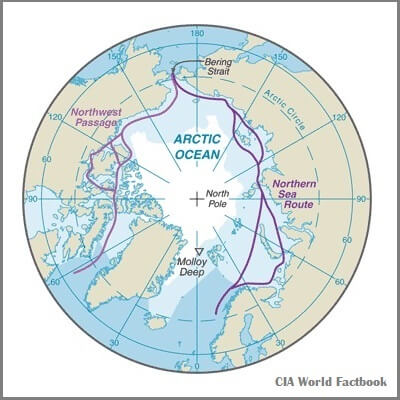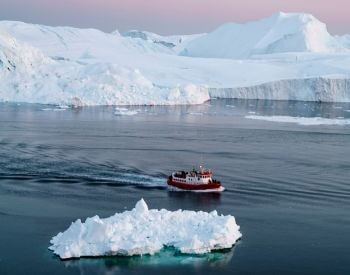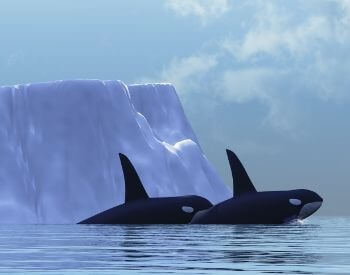
- Ocean Name: Arctic Ocean
- Location: Covers the Arctic, Borders North America and Eurasia
- Average Depth: 3,953 feet
- Total Surface Area: 6 million mi2
- Total Coastline: 28,203 miles
- Total Volume of Water: 160.7 million mi3
26 Arctic Ocean Facts for Kids
- The Arctic Ocean is one of the world’s five oceans.
- The Arctic Ocean borders the Arctic and borders Eurasia and North America.
- There are six countries that have a border along the Arctic Ocean. Those countries are Canada, Iceland, Greenland, Norway, Russia and the United States of America.
- The Arctic Ocean has the lowest salinity levels of all five major oceans. This is due to the large flow of freshwater into the Arctic Ocean and its low rate of evaporation.
- The total volume of the Arctic Ocean is 160.7 million mi3 of water.
- The Arctic Ocean contains 1.4% of all the world’s ocean water.
- The Arctic Ocean is the smallest of all five oceans.
- The total surface area of the Arctic Ocean is 6 million mi2.
- The average depth of the Arctic Ocean is 3,953 feet.
- The deepest part of the Arctic Ocean is 18,210 feet in the Fram Strait.
- The Arctic Ocean is the shallowest ocean in the world.
- The total coastline of the Arctic Ocean is 28,203 miles.
- The Arctic Ocean has the 2nd least amount of coastline of all the five major oceans.
- The surface temperature of the Arctic Ocean is just above the freezing point of seawater at 28.8 °F.
- The Arctic Ocean has the coldest temperatures of all five major oceans.
- The Arctic Ocean is almost entirely covered by sea ice during the winter season.
- The biggest see of the Arctic Ocean is the Barents Sea.
- The first nautical crossing of the Arctic Ocean was by Norwegian explorer Fridtjof Nansen in 1896.
- The North Pole, the most northern point of Earth’s axis of rotation, is in the Arctic Ocean.
- Polar bears (Ursus maritimus) live and hunt around the Arctic Ocean.
- The infamous sinking of the RMS Titanic was caused by an iceberg from the Arctic Ocean.
- The ecosystem of the Arctic Ocean is fragile and is easily disrupted by climate change.
- Estimates claim that climate change could cause the Arctic Ocean to be ice free during the summer by 2040.
- The freshwater dumped into the world’s ocean by melting ice in the Arctic Ocean can cause a lot of issues.
- The climate of the planet could change as the salinity levels of the world’s oceans drop as ice melts in the Arctic Ocean, which would affect global ocean current patterns.
- Cities near the coast will be at risk of flooding as ice melts in the Arctic Ocean. In some cases, these coastal cities could be completely underwater.
Pictures of the Arctic Ocean

A picture of ice and icebergs floating in the Arctic Ocean.

A picture of a boat sailing through the Arctic Ocean.

A picture of two orca whales swimming in the Arctic Ocean.
Additional Resources on the Arctic Ocean
- About the Arctic Ocean – Find more information about the Arctic Ocean on the Smithsonian Ocean website.
- How Big is the Arctic Ocean – Discover how big the Arctic Ocean is and other facts on the World Wild Life website.
- Arctic Ocean – The World Factbook – Find more facts about the Arctic Ocean on the CIA World Factbook website.
- Arctic Ocean – Britannica – Explore the Britannica website to learn more about the Arctic Ocean.
